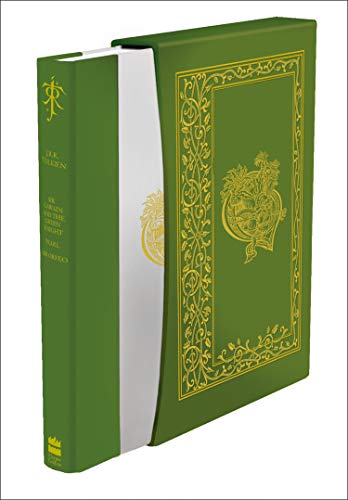LanceFormation wrote:
Trotter wrote:
Not sure that this would have sold for more than a few pounds a couple of years ago.
But what an unusual rebind…
Yeah, I suspect it was rebound part way through its library life, as I can't see any other reason for losing so much of the gutter.
I certainly wouldn't be paying £500 for it. I paid $50 for an ex-lib '46 a few years ago (with the original binding).
1956 The Hobitt ,2nd Edition 8th Impression, rare book ,collectors must. It is in good condition little signs of wear ,age related, but still a sought after book
Trotter wrote:
1956 The Hobitt ,2nd Edition 8th Impression, rare book ,collectors must. It is in good condition little signs of wear ,age related, but still a sought after book
I guess "good condition" just means whatever we want it to mean, huh?
Mr. Underhill wrote:
I guess "good condition" just means whatever we want it to mean, huh?
In the definition of "condition" from ABC For Book Collectors (8th Edition), Carter and Barker:
"Such terms are inevitably subjective, and collectors should be warned that the seemingly objective sequence from 'mint' (good) to 'good' (bad), which has crept into the lower end of the book market from philately, is as much a matter of personal opinion."
Urulókë wrote:
Mr. Underhill wrote:
I guess "good condition" just means whatever we want it to mean, huh?
In the definition of "condition" from ABC For Book Collectors (8th Edition), Carter and Barker:"Such terms are inevitably subjective, and collectors should be warned that the seemingly objective sequence from 'mint' (good) to 'good' (bad), which has crept into the lower end of the book market from philately, is as much a matter of personal opinion."
Right they are Urulókë. I know that these terms are always going to mean different things to different people. "Fine" "Very Good" "Good" "Acceptable" & "Poor" is the spectrum that most stick to I have found.
The problem is, that even with broadly accepted meanings, "Good" actually means "Not remotely good". And "Near fine" seems to mean "reasonable nick, but with lots of faults" according to most book dealers, these days.
I think there is an invasion of rating terms from comics going on. In the comics world, the scale of conditions, from worst to best, goes thus:
Poor, fair, good, very good, near fine, fine, mint.
So "good" in comics isn't very good at all, for more durable items like books.
Poor, fair, good, very good, near fine, fine, mint.
So "good" in comics isn't very good at all, for more durable items like books.
I think it has more to do with the relatively recent (in book collecting terms) collecting of "Modern First Editions". In antiquarian bookselling terms "Good" was never the kind of good collectors of modern dustjacketed books were/are looking for. If you frequent lists of 19th century books the idea that any of these could be graded better than "VG" (in comparison to a new book) just isn't likely. A 1850's book graded at "VG" is about as good as you're likely to find. A "good" copy would still be totally respectable from a collecting perspective. But for recent books that kind of condition wouldn't be acceptable as practically new copies do exist & are out there. A "good" modern book is, therefore, not very good...
Khamûl wrote:
I think it has more to do with the relatively recent (in book collecting terms) collecting of "Modern First Editions". In antiquarian bookselling terms "Good" was never the kind of good collectors of modern dustjacketed books were/are looking for. If you frequent lists of 19th century books the idea that any of these could be graded better than "VG" (in comparison to a new book) just isn't likely. A 1850's book graded at "VG" is about as good as you're likely to find. A "good" copy would still be totally respectable from a collecting perspective. But for recent books that kind of condition wouldn't be acceptable as practically new copies do exist & are out there. A "good" modern book is, therefore, not very good...
Yep, this is my take on it.
Stu wrote:
Khamûl wrote:
I think it has more to do with the relatively recent (in book collecting terms) collecting of "Modern First Editions". In antiquarian bookselling terms "Good" was never the kind of good collectors of modern dustjacketed books were/are looking for. If you frequent lists of 19th century books the idea that any of these could be graded better than "VG" (in comparison to a new book) just isn't likely. A 1850's book graded at "VG" is about as good as you're likely to find. A "good" copy would still be totally respectable from a collecting perspective. But for recent books that kind of condition wouldn't be acceptable as practically new copies do exist & are out there. A "good" modern book is, therefore, not very good...
Yep, this is my take on it.
Yes, I agree with what all are saying on this. This is exactly why it's so important to get as many images of the item as you can from the dealer or seller. Because the terms are so subjective buying an item site unseen is rolling the dice big time.














 2440
2440 1.07M
1.07M